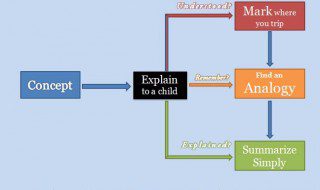Let’s get it straight – ‘concept’ is the most used word in describing academic success (or failure). This has been the Achilles heel in your test preparation, even worse if you’re trapped in viva-voce, because you thought you got it, but in the moment of need you forget it. As Richard Feynman once said, “I learned very early the difference between knowing the name of something and knowing something.”
Fret not, here’s a quick fix for grasping the concept and trapping it unforgettably in your brain. This is not a tedious way; depending on the topic, you can do it in as little as 5 minutes. I’m not joking, it’s the Feynman technique. Feynman was the genius physicist with an autobiography “Surely You’re Joking, Mr. Feynman!” which kind of covers the explanation. So hold tight and read on.
Where can this technique be used?
- When you are about to learn an important conception
- Where you want to ensure that you have properly learnt it
- When you have a test coming up and have to crack chapters real quick!
When not to use the technique?
- For memorization purposes, like Richard Feynman was born on May 11, 1918 in Manhattan, New York City.
- When there is no other form of perception in use; i.e. just rolling it over in your head might not be sufficient to do the trick, you have practically “Do” something. Examples are to follow.
The Step-by-Step Tutorial:
- Choose the Concept
Decide how to properly call that concept, and once you have settled, you may get a blank sheet and write it down on top as you would want to visualize it.
- Explain it to a 5-year old
No, getting a child to listen to your woes is not really what we mean, and I’m pretty sure it won’t be recommended either. What I am trying to say is pretend to teach it to a 5-year old kid. Just attempt to properly teach, and be honest in that; do not fool yourself. Explain it using simple words, not jargons, and no need to be picky about the style, do it in a way your imaginary 5-year old student would be satisfied and left without doubt.
- Mark where you are stumbling
There is a major chance you would not succeed in doing step two in one go. In that case, whenever you get stuck or run out of ideas, get straight back to the text and pinpoint the exact area you are failing to grasp. These are the parts you need to revise with care.

- Go crazy with analogy
If you are stuck with lack of simple words, go the analogy way; find a casual metaphor to do the explanation for you. This way, the chance of your understanding and remembering increases. Like, Proboscis of a butterfly is an elongated sucking mouthpart that is typically tubular and flexible, which is totally a honey-collecting straw stuck on your mouth, right?
- Organize and Summarize
Rephrasing and summarizing are important. Try writing down the simple version of yours to sustain the longevity of the concept in your brain.
The Feynman technique can be considered as the easiest and also very effective way to get the toughest bits to work in your favor. So don’t wait anymore, grab a pen and a paper and start cracking the odds !


